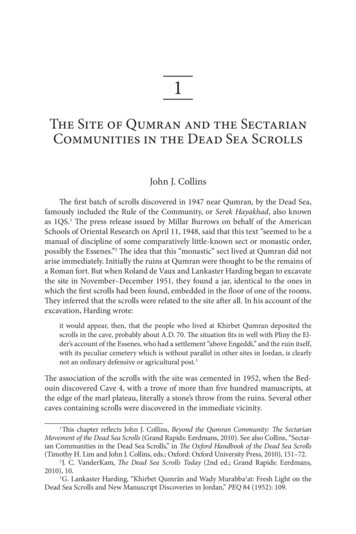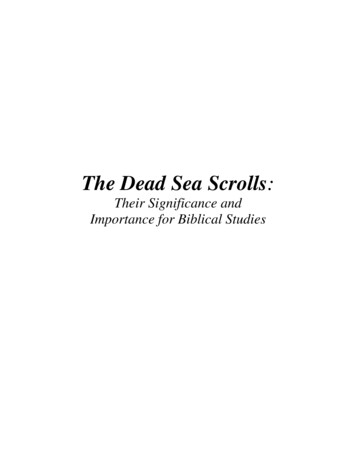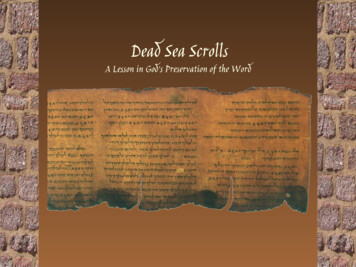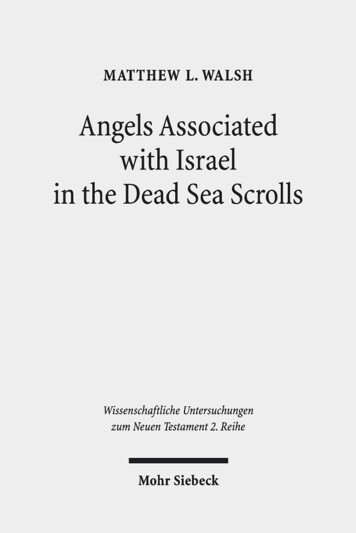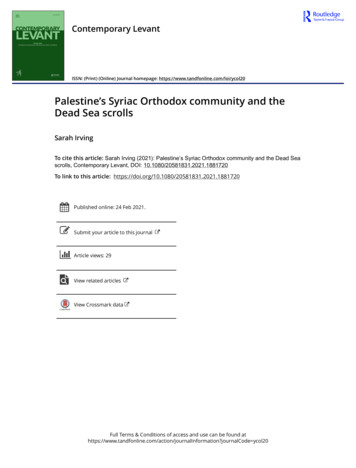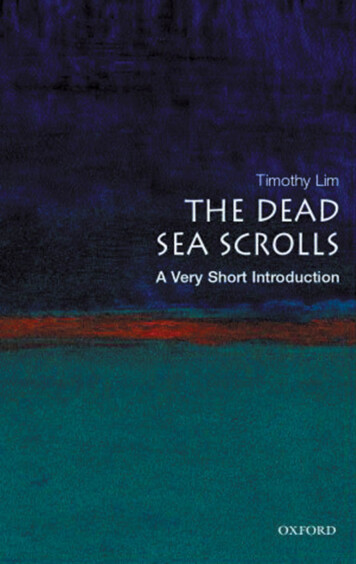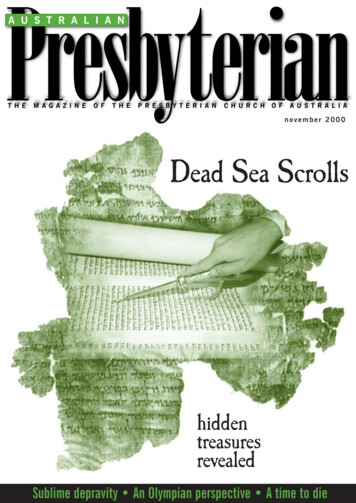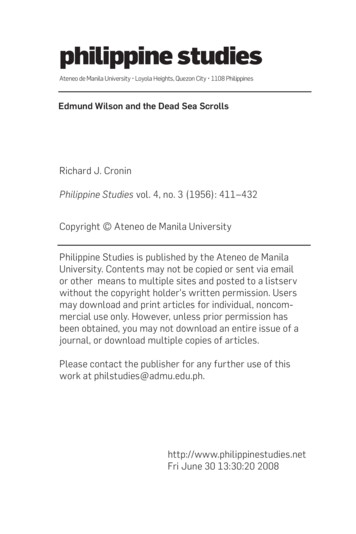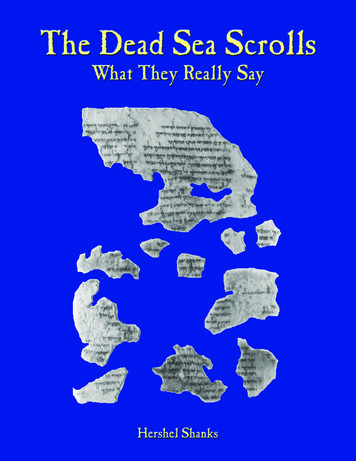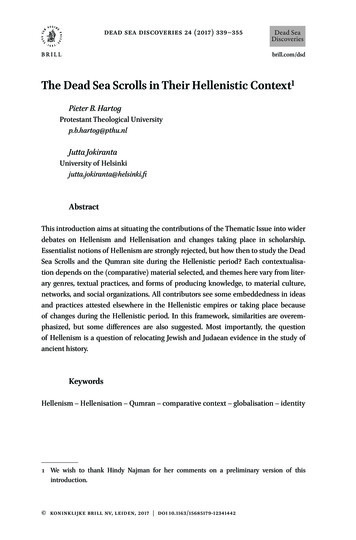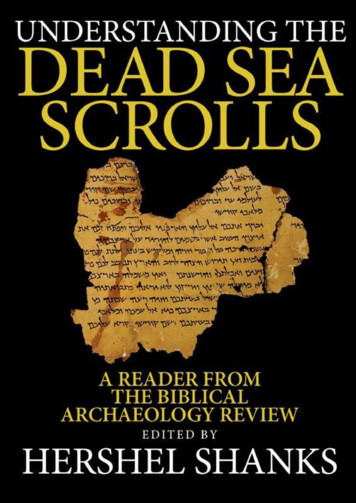
Transcription
Understanding The Dead Sea ScrollsBOOKS BY HERSHEL SHANKSThe City of David: A Guide to Biblical JerusalemJudaism in Stone: The Archaeology of Ancient SynagoguesThe Dead Sea Scrolls After Forty Years (with James C. VanderKam, P.Kyle McCarter, Jr., and James A. Sanders)BOOKS EDITED BY HERSHEL SHANKSThe Art and Craft of Judging: The Opinions of Judge Learned HandAncient Israel: A Short History from Abraham to the RomanDestruction of the TempleChristianity and Rabbinic Judaism: A Parallel History for the First SixCenturiesRecent Archaeology in the Land of Israel (with Benjamin Mazar)Archaeology and the Bible: The Best of BAR (two volumes) (with DanP. Cole)
Understanding The Dead Sea ScrollsA Reader from the Biblical Archaeology ReviewEdited byHershel ShanksOriginally published by Vintage BooksA Division of Random House, Inc.New YorkFirst Vintage Books Edition, July 1993
Copyright 1992 by Biblical Archaeology SocietyAll rights reserved under International and Pan-American CopyrightConventions. Originally published in the United States by VintageBooks, a division of Random House, Inc., New York, andsimultaneously in Canada by Random House of Canada Limited,Toronto. Originally published in hardcover by Random House, Inc.,New York, in 1992.Portions of this work were previously published in BiblicalArchaeology Review and Bible Review.Grateful acknowledgment is made to Jonathan Cape for permission toreprint excerpts from The Dead Sea Scrolls Deception by MichaelBaigent and Richard Leigh (published in the United States by Simonand Schuster). Reprinted by permission.Library of Congress Cataloging-in-Publication Data Understanding theDead Sea scrolls: a reader from the Biblical archaeology review /edited by Hershel Shanks.—1st Vintage Books ed.p. cm.“July 1993”—T.p. verso.Originally published: New York: Random House, c1992.“Portions of this work were previously published in Biblicalarchaeology review and Bible review”—T.p. verso.Includes index.ISBN 0-679-74445-2 (pbk.)1. Dead Sea scrolls. I. Shanks, Hershel. II. Biblical archaeology review.
AcknowledgmentsThis book is truly a collective effort. It is a pleasure to express thegratitude of the Biblical Archaeology Society for the contributions somany people have made to this book.First and foremost, our thanks go to the authors of the variouschapters and to the photographers of the illustrations.Two of the authors have died—my friend Yigael Yadin and HarryThomas Frank. I wish they were here to see their words reprinted inthis form.Only someone who has coordinated a project like this and seen itthrough to fruition can appreciate the contribution of the publisherof Biblical Archaeology Review and Bible Review, Susan Laden—atireless worker of infallible judgment.The managing editor of Biblical Archaeology Review and Bible Review,Suzanne F. Singer, organized the pictures and gave her final approvalto the editorial product. She was ably assisted by Nita Sue Kent andCarol Andrews, who copyedited the entire text.The charts and maps were prepared by Auras Design.A special expression of thanks goes to Professor James C. VanderKamof the University of Notre Dame and Professor Lawrence H.Schiffman of New York University for serving as informal consultantsand technical advisors. That there are remaining errors is, as Iexpress below, my fault, not theirs. There is no way to record,however, the many errors from which they saved us.Is there more? Yes, people had to search for the best photographsthat could be found. The text had to be input and proofed,biographies of the authors had to be prepared, citations had to bechecked. It is with great gratitude that we thank Janet Bowman,Coleta M. A. Campanale, Jennifer Horn, Cheryl R. W. McGowan,Katherine Munro, and Judith Wohlberg.My experience is that few authors are satisfied with their publisher.
We are an exception. We are grateful for the work of our RandomHouse editor Jason Epstein (whom Norman Mailer has accuratelycalled the “bona fide mandarin of American letters”) and his assistanteditor Maryam Mohit.Robert B. Barnett, Esq., handled our formal relations with RandomHouse—not only successfully but amiably.To all, we express our thanks.I have elsewhere written that it is impossible to write about the DeadSea Scrolls without making errors. I have no doubt that that is thecase here. I can only record that the responsibility for the errors ismine and apologize in advance. If the readers of Biblical ArchaeologyReview and Bible Review are any indication of what I can expect, Iwill hear in no uncertain terms from readers of this volume. I hopewe have an opportunity to correct these errors in future printings.Hershel ShanksEditor, Biblical Archaeology Review and Bible ReviewFebruary 1, 1992Washington, D.C.
ContentsOF CAVES AND SCHOLARS: AN OVERVIEWHershel ShanksI THE FIND1. DISCOVERING THE SCROLLSHarry Thomas Frank2. THE HISTORICAL CONTEXT OF THE SCROLLSFrank Moore CrossII WHERE THEY CAME FROM3. THE SADDUCEAN ORIGINS OF THE DEAD SEA SCROLLSECTLawrence H. Schiffman4. THE PEOPLE OF THE DEAD SEA SCROLLS: ESSENES ORSADDUCEES?James C. VanderKam5. “FIRST DEAD SEA SCROLL” FOUND IN EGYPT FIFTY YEARSBEFORE QUMRAN DISCOVERIESRaphael Levy6. ESSENE ORIGINS — PALESTINE OR BABYLONIA?Hershel ShanksIII THE TEMPLE SCROLL7. THE TEMPLE SCROLL—THE LONGEST DEAD SEA SCROLLYigael Yadin8. THE GIGANTIC DIMENSIONS OF THE VISIONARY TEMPLEIN THE TEMPLE SCROLLMagen Broshi9. INTRIGUE AND THE SCROLL
Hershel Shanks10. IS THE TEMPLE SCROLL A SIXTH BOOK OF THE TORAH—LOST FOR 2,500 YEARS?Hartmut StegemannIV THE DEAD SEA SCROLLS AND THE BIBLE11. THE TEXT BEHIND THE TEXT OF THE HEBREW BIBLEFrank Moore Cross12. LIGHT ON THE BIBLE FROM THE DEAD SEA CAVESFrank Moore Cross13. WHEN THE SONS OF GOD CAVORTED WITH THEDAUGHTERS OF MENRonald S. HendelV THE DEAD SEA SCROLLS AND CHRISTIANITY14. THE DEAD SEA SCROLLS AND CHRISTIANITYJames C. VanderKam15. AN UNPUBLISHED DEAD SEA SCROLL TEXT PARALLELSLUKE’S INFANCY NARRATIVEHershel Shanks16. WAS JOHN THE BAPTIST AN ESSENE?Otto BetzVI THE DEAD SEA SCROLLS AND RABBINICJUDAISM17. NEW LIGHT ON THE PHARISEESLawrence H. SchiffmanVII THE COPPER SCROLL18. THE MYSTERY OF THE COPPER SCROLLP. Kyle McCarter, Jr.VIII RECONSTRUCTING THE SCROLLS19. HOW TO CONNECT DEAD SEA SCROLL FRAGMENTS
Hartmut StegemannIX CONTROVERSY AND THE SCROLLS20. INTERVIEW WITH CHIEF SCROLL EDITOR JOHNSTRUGNELLAvi Katzman21. SILENCE, ANTI-SEMITISM, AND THE SCROLLSHershel Shanks22. IS THE VATICAN SUPPRESSING THE DEAD SEA SCROLLS?Hershel ShanksNotesAbout the AuthorsSources and Dates of Original Articles
Illustrations and Charts1. Dead Sea Scroll Caves2. Settlement at Qumran3. The Shrine of the Book4. The Shrine of the Book, interior5. The Isaiah Scroll6. The Scrollery7. Cave 18. The Bedouin shepherds of the first discovery9. Scroll jars10. A scroll from Cave 111. Cairo Genizah where the Damascus Documents were found12. Cairo synagogue housing the genizah13. Column from Damascus Document14. The Temple Scroll at recovery15. Fragments of the Temple Scroll16. Interior of Cave 1117. Unrolling the Temple Scroll18. The Temple Scroll19. Plan of visionary temple and courts20. Comparison of visionary temple and walled Jerusalem21. Yigael Yadin22. Mr. Z23. Discovery sites24. Local Texts Theory25. Canon of Hebrew Bible and excluded texts26. Fragment from book of Samuel27. Fragment from Deuteronomy28. A water installation at Qumran29. The Copper Scroll, before cutting30. The Copper Scroll, after opening31. The Copper Scroll, on display in Amman32. The Copper Scroll, a new photograph33. Pattern of damage on the War Scroll34. The Psalm Scroll35. The Temple Scroll36. Unjoined fragments from Songs of the Sabbath SacrificeScroll37. Father Jean Starcky at Qumran
38. In the École Biblique39. J. T. Milik, 1950s40. John Allegro, 1950s41. John Strugnell, 1950s
Of Caves and Scholars: An OverviewHERSHEL SHANKSThe Dead Sea Scrolls are the greatest manuscript discovery of thetwentieth century, certainly as concerns biblical studies. Amidstconfusion and speculation, they have ignited the imagination ofnonscholar and scholar alike. It is easy to understand why. A libraryof over eight hundred texts, they cast a direct light on the criticalperiod more than two thousand years ago out of which bothChristianity and rabbinic Judaism emerged.In 70 A.D., the Romans destroyed Jerusalem and its Temple. Thatyear has functioned as a kind of impenetrable wall to students ofrabbinic Judaism and early Christianity: It has been extremelydifficult to go behind it. Out of the variety of Judaisms that vied forinfluence while the Temple still stood, after 70 there emerged thesingle normative Judaism we call rabbinic, the Judaism we knowtoday. The only other form of “Judaism” to survive the tragedy of 70was Christianity, which, as transformed of course, came to dominatethe Western world.Yet the earliest post-70 document of rabbinic Judaism, the Mishnah,dates to about 200 A.D. While Paul’s letters were written before theRoman destruction of Jerusalem, other Christian literature, exceptperhaps the gospel of Mark, was not. This is why it has been difficultfor scholars to understand how these two major movements—rabbinic Judaism and Christianity—emerged out of the extraordinaryvarieties of pre-70 Judaism. How did rabbinic Judaism andChristianity develop from the soil, the same soil, of pre-70 Judaism?Suddenly, in our time, the Dead Sea Scrolls provide scholars with avast library of over eight hundred volumes that sheds a direct light—undistorted by later editors with their own ideologies and biases—onpre-70 Judaism. The promise—by no means yet fully realized—is aclearer understanding of how these two major religious movementsdeveloped in their formative stages.1
The term Dead Sea Scrolls is imprecise. In a narrow sense, Dead SeaScrolls refers to the inscriptional materials found in eleven caves inthe Wadi * Qumran on the northwest shore of the Dead Sea. Butscholars often include manuscripts found in other nearby sites alongthe Dead Sea—Wadi Murabba ‘at, Nahal† Hever, Khirbet Mird, andeven Masada. On occasion, the term also includes documents found inthe Wadi Daliyeh north of Jericho. For the most part, however, thisbook will discuss the Dead Sea Scrolls in the narrow sense—that is,the documents found in eleven caves in the Wadi Qumran. Thedocuments from nearby sites (except Masada) date from differentperiods than the documents found in the Wadi Qumran and thereforeraise entirely different problems. Dealing with the Wadi Qumranfinds is enough for one book.Another problem is the meaning of the word scroll. The first sevenscrolls plus fragments of others were found in a cave in 1947 by aBedouin shepherd. Thereafter, the Bedouin and archaeologistsscoured other caves looking for other manuscripts. Between 1952 and1956, ten other caves were found in the Wadi Qumran containinginscriptional materials (I say “inscriptional materials” because one ofthe eleven caves contained only a small inscription on a piece ofpottery—an ostracon). In these caves, which were subsequentlynumbered 1 through 11, hundreds of other manuscripts were found.But only a handful were intact scrolls. Depending on what one meansby intact, between three and five intact scrolls, in addition to theseven intact scrolls found in Cave 1, were eventually recovered. Therest were mere fragments. So it can be a little misleading, unless youunderstand their fragmentary nature, to describe these documents asscrolls. They were once scrolls, but all that is left are mere scraps,pieces often no bigger than a fingernail.Of the over eight hundred different manuscripts scholars haveidentified from the eleven caves, some consist of only a singlefragment. In others, there are many pieces. In some cases, thefragments are large. In others, they are very small. Yet even the scrapscan tell us a great deal.2
1. The Dead Sea Scroll caves are in the cliffs at center. At right is the WadiQumran leading to the Dead Sea to the east. Beyond is ancient Moab, nowJordan.David Harris3
2. The settlement at Qumran as excavated. Some of the caves where scrolls werefound are located in the spur at left.Werner BraunClearly these are the remains of an important library in antiquity, butwhere the library came from and who wrote the documents is amatter of dispute. Some scholars say they were written in a nearbysettlement the remains of which is called Qumran. Others say thatthe library must have come from Jerusalem, brought here forsafekeeping when the Romans attacked the city, ultimatelydestroying it in 70 A.D. In either event, it is clear that the Qumranmanuscripts constituted a vast and varied library for its time.The documents were written between about 250 B.C. and 68 A.D.,when, according to its excavator, the nearby settlement of Qumranwas destroyed by the Roman army in anticipation of its attack onJerusalem. Although that is when the documents were written, somemay have been composed much earlier. Indeed, the earliest4
documents among the Dead Sea Scrolls were actually written beforethe establishment of the nearby settlement with which they are oftenassociated.The period of Jewish history in which the Dead Sea Scrolls werewritten is one of extreme complexity, documented only inambiguous sources. Governments were unstable and often failed toinsure social tranquility. Violence erupted frequently. Religiouspolitics played a major role in securing social stability—or indestroying it. In the second century B.C. the Maccabees, a family ofJews from Modi’in in central Palestine rebelled against the Assyrian(Seleucid* ) overlord Antiochus IV Epiphanes who then ruled theland of the Jews. The ultimately successful Maccabean-led liberationof the Jerusalem Temple is still celebrated in the Jewish festival ofHanukkah. In fact, the struggle for an independent Jewish state lastedfor a quarter of a century, finally culminating in the establishment ofthe Hasmonean dynasty of Jewish rulers. Even before the Maccabeanrevolt, bribery had led to the appointment of high priests who werenot of the Zadokite line established by King Solomon. Thisusurpation, it was charged, continued under the Hasmoneans. TheHasmonean rulers combined both political and religious authorityand were bitterly opposed by various religious segments of thepopulation, not only for what was regarded as a usurpation of thehigh priesthood, but also for the unique synthesis of Hellenism andJudaism they espoused. The Hasmonean dynasty was followed in themid-first century B.C. by the Herodian period, named for its mostillustrious figure, Herod the Great (37–4 B.C.).In the Hasmonean period, numerous, often competing Jewishreligious groups, sometimes referred to as sects, had begun to form.They continued to vie for influence in the Herodian period. The bestknown of these were the Pharisees, the only group (other than theChristians) to survive the Roman destruction of Jerusalem in 70 A.D.Thus, Pharisaic thought became the foundation of rabbinic Judaism,the Judaism that has survived to this day. But numerous otherJewish groups jostled one another in the pre-70 period. Theseincluded the Sadducees and Essenes, described by the Jewishhistorian Josephus (c. 37–100 A.D.).The Sadducees were a priestly, aristocratic party commandingsignificant wealth and political prominence. They served asdiplomats as well as military leaders. They also claimed to be the only5
legitimate priests, apparently taking a stricter approach to many legalmatters than the Pharisees. Unfortunately, the Sadducees left noliterature of their own—unless it is reflected in the Dead Sea Scrolls.Thus we don’t know how the Sadducees would have describedthemselves. All our descriptions—the most important come from theJewish historian Josephus and the New Testament—are mildly orintensely antagonistic.The Pharisees are better known. It is they who ultimately shapedJewish life to our own day. The name appears to derive from theHebrew word parush, meaning “separated” or “standing apart.” Mostof what we know about the Pharisees, however, comes from laterrabbinic references. The references to them in the New Testament areobviously antagonistic—and biased. The Pharisees appear to havebeen the most popular Jewish group among the populace. Althoughit is commonly thought that their determinations of religious lawswere more moderate and lenient than those of the Sadducees, this isby no means invariably the case. Thus it is difficult to characterizethe difference in their beliefs in a sentence or two. The Pharisees did,however, accept the Oral Law as the authentic amplification of theWritten Law of Moses, unlike their rival Sadducees.The Essenes were, by comparison with the Pharisees, a smallergroup. Oddly, however, Josephus describes them in greater detailthan either the Pharisees or the Sadducees—perhaps because hethought his readers would be fascinated by a group exhibiting suchcurious and exotic behavior. The sect was governed by a tightorganization with rigorous rules for acceptance and clearly definedpenalties. Although Essene groups lived all over the country,including Jerusalem, a small subgroup of them lived in a settlementin the desert by the Dead Sea. Their lives were dedicated to strictobservance of the law. We shall learn a great deal more about them inthe discussion of the sectarian documents found among the Dead SeaScrolls.These three groups were not the only ones active in Jewish life.There were numerous others—the Hasidim, the Zealots, the Sicarii,the Boethusians, and toward the end of this period, the earlyChristians.The Dead Sea Scrolls can be divided into two groups: biblical textsand nonbiblical texts. Between 20 and 25 percent of the documentsare biblical texts. Every book of the Hebrew Bible is represented, at6
least by a fragment, except the book of Esther. Whether bycoincidence or not, Esther is the only book of the Hebrew Bible thatdoes not mention the name of God.The biblical texts are easier for scholars to deal with than thenonbiblical texts even though only small fragments of a book mayhave survived. The biblical text is known from later copies thatprovide a kind of template on which to fit the Qumran fragments.This is also true of some of the nonbiblical texts, such as the books ofEnoch and Jubilees, that were previously known to us.But many of the nonbiblical texts were entirely unknown to us beforethey were found in the Qumran caves and it is often difficult toarrange the fragments of these texts in any meaningful order.The nonbiblical texts are remarkably varied and can be subdivided inseveral ways, for example, by genre: hymns and psalms, biblicalcommentaries, wisdom literature, legal texts, a letter,pseudepigrapha,* a designation of hidden treasure. Another way tosubdivide them is by whether a text is a so-called sectarian text ornot—that is, does it represent the concepts and ideas of the particularreligious group that collected this library?Some texts—the sectarian ones—seem to reflect the rules and beliefsof a unique sect or group of Jews. Scholars refer to this group as theQumran sect. But what was this sect? The usual answer is that it wasthe Essenes, mentioned not only by Josephus but also by Pliny theElder (23–79 A.D.) and Philo (c. 20 B.C.–50 A.D.). But other scholarsquestion this identification. Two chapters in this book vigorouslydebate the issue.* Those who challenge the Essene identificationargue that the so-called sectarian texts often seem inconsistent withEssene doctrine as reflected in independent sources and are eveninconsistent among themselves. For example, how do the militant,even warlike, statements in some Qumran texts square with thecommonly held view that the Essenes were pacifists?7
3. The Shrine of the Book, Jerusalem, where the seven intact scrolls from Cave 1are housed.David Harris8
4. The Shrine of the Book, interior. The great Isaiah Scroll is wound around thelighted drum in the center of the upper floor.Werner Braun9
5. The great Isaiah Scroll in the Shrine of the Book.Werner BraunOther questions concern the Qumran settlement itself. What is itsrelationship to the scrolls? Were the scrolls written there? Did thelibrary belong to the settlement? Or were the scrolls brought to thecaves by others who may or may not have had some relationship tothe settlement? Qumran was excavated between 1951 and 1956 byPère Roland de Vaux of the École Biblique et Archéologique Françaisein Jerusalem who died in 1971 without writing a final report on hisexcavation. De Vaux, a Dominican father, regarded the settlement as akind of monastery. Professor Norman Golb of the University ofChicago believes it was a military fort. Scholars now preparing thefinal excavation report on the basis of records left by de Vaux suggestthe site may have been a winter residence, a kind of desert plantation,for wealthy, and perhaps powerful, Jerusalemites.The site contained a great many water installations. But were they alldrinking water cisterns? Or were some for bathing? And if so, weresome for ritual bathing?De Vaux excavated part of a large cemetery adjacent to the site andfound among the nearly one thousand graves the remains of two10
females and a child. Were they simply female servants or does thisdestroy the theory that the monks who lived here were celibate andthat Qumran was entirely male?The seven large intact scrolls from Cave 1 were published reasonablysoon after they came into scholarly hands—by Israeli and Americanscholars. Over the years, the fragmentary texts from other caves (aswell as from Cave 1) were also published—with the exception of thefragmentary texts from Cave 4. But problems with the Cave 4 textswould eventually discredit the entire publication enterprise.Cave 4 presented a special problem from the outset. Like most of thefinds, Cave 4 was discovered by the Bedouin. It proved to be therichest of all the caves, with over five hundred different manuscripts—but all in tatters. Not a single intact scroll was recovered from thisjumbled mess. Yet this cache represented over five-eighths of theQumran texts— approximately five hundred of a total ofapproximately eight hundred manuscripts.While the number of discrete manuscripts found in Cave 4 isapproximately five hundred, the number of fragments is muchlarger. Estimates range from ten thousand to one hundred thousand,the most common being about fifteen thousand fragments from thiscache. In effect, the fragments constitute a giant jigsaw puzzle—ormore accurately, five hundred different jigsaw puzzles with 90percent of the pieces missing.But this was not the worst of it. If the Bedouin who discovered Cave4 sold the fragments on the antiquities market to various dealers, itwould be impossible ever to assemble the fragments in one place, andscholars would never have been able to work on the surviving piecesof the jigsaw puzzles.To avoid this, an arrangement was made with the Bedouin in theearly 1950s to purchase the fragments from Cave 4 for one Jordaniandinar per centimeter (then 5.60). The money to purchase thefragments was provided by a group of so-called national schools—that is, foreign schools in east Jerusalem devoted to archaeologicaland biblical research. Among those participating were the French,the Americans, the English, and the Germans. The Vatican was also asource of funds. It was agreed that after the fragments had beenassembled into discrete documents and then published, the originalswould be divided among the various national schools that provided11
the funds to purchase them. In this way, the cache was kept togetherand assembled in what was then a private museum in Jerusalem, thePalestine Archaeological Museum (now the Rockefeller Museum).To work on the texts, an international team of young scholars wasassembled under Jordanian auspices since at the time Jordancontrolled what is now called the West Bank where the scrolls werefound as well as east Jerusalem where the contents of the caves wereassembled. The team would include no Jews and the task ofassembling it fell to Père de Vaux. The German member of the group,Claus Hunzinger, soon resigned, leaving a seven-man team of youngscholars, mainly Catholic clerics, who set to work fitting the piecesof the jigsaw puzzles together.The work took place in a long museum room that they called theScrollery. Some of the conditions there would today be regarded ashorrendous, but that was then. Little effort was made to preventdeterioration of the fragments. No record was made of the originalfragments in their original condition. Pictures show the youngscholars working in a room with the windows open and the sunstreaming in, holding fragments in their hands while smokingcigarettes. As the young scholars—the oldest was thirty-two—soughtto divide the fragments into discrete documents and to look forpossible joins, any one of them was free to move fragments aroundunder the glass plates.By the late 1950s, the team of scholars had substantially completedthe task of arranging the fragments. I say substantially completedbecause the task of arranging the fragments will never be complete;there will always be room for improvement. The next generation ofscholars will always find new connections. And indeed today’s teamof scholars continues to improve the arrangements.With the fragments thus arranged into discrete documents, the teamdivided the five hundred different texts among themselves forpublication. In hindsight, this was an act of enormous hubris andgreed. They clearly took on more work than they could complete in alifetime. Only one scholar on the team, John M. Allegro of England,published his entire assignment, but his work was so bad that anarticle correcting it is longer than his original publication. On theother hand, Allegro did get his texts out—which is more than can besaid for any of the others.12
By the late 1950s the team succeeded in making transcripts of thetexts by simply writing down the letters in an easily readable form asone might study a handwritten letter by a poor penman or onewritten in eighteenth-century style. In the case of the Qumranfragments, the letters are often difficult to read—not so muchbecause they were originally obscure, but because of the ravages oftime.As the transcripts were being completed, arrangements were made tohave four other young scholars create a concordance of thenonbiblical texts, listing each word in the text, indicating thedocument in which it appeared, the column, the line, and theadjacent words.* This concordance would be an invaluable tool foranyone attempting to translate and understand these often obscureHebrew and Aramaic texts.This brings the story of the Cave 4 team up to about 1960. In the nextthirty years the team managed to publish less than one hundred oftheir five hundred texts—approximately 20 percent of theirassignment. The four hundred unpublished texts compriseapproximately half of the total number of Qumran manuscripts.According to a scholarly convention that is nowhere written or evenreferred to in writing, a scholar who is assigned to publish a text hascomplete control over it. That person may take as long as he or shelikes to publish it. It can be seen by others only with the scholar’spermission. No one else is permitted to print the text.13
6. The Scrollery in the 1950s, with fragments from Cave 4 under glass plates andthe sun pouring in.Israel Antiquities AuthorityThe Cave 4 team asserted these “publication rights” with avengeance. Several of the original team members have died and“bequeathed” their “publication rights” to trusted colleagues, whothen themselves exercise the right to exclude others. Requests byoutside scholars to see various texts have been turned down. Teammembers have even “given” texts to their graduate students, whileexcluding senior scholars.Over the years, the discontent of excluded scholars mounted. In 1977,Oxford don Geza Vermes, one of the excluded scholars, made hisnow-famous prediction that the Dead Sea Scrolls publication projectwould become “the academic scandal par excellence of the twentiethcentury.” Ten years later, Vermes commented that what he hadforecast had become a reality.In 1985, as editor of Biblical Archaeology Review, I attended ascholarly conference at New York University at which scroll editor14
John Strugnell addressed his audience of Qumran scholars. Strugnellwas the only member of the team there; he alone had access to thetexts. He spoke with an authority only he could command. MortonSmith, a distinguished professor from Columbia University, calledthe situation “disgusting.” Other scholars were obsequiously gratefulfor whatever Strugnell dribbled out to them; inwardly they wereseething with resentment.That marked the beginning of a six-year campaign by BiblicalArchaeology Review to free the Dead Sea Scrolls.In all fairness, it must be recognized that as the pressure mounted,the editing team responded by speeding up the process. After JohnStrugnell became chief editor in 1987, he expanded the team, addingJews and Israelis for the first time. He convinced one of the originalmembers of the team, J. T. Milik, to relinquish a major portion of hisoriginal hoard for reassignment to younger scholars. In consultationwith the other editors, he fixed a “Suggested Timetable” forcompletion of the work.At the same time the Israel Antiquities Authority (then theDepartment of Antiquities) began for the first time to assert itselfwith regard to the problem of Dead Sea Scroll publication.Israel obtained physical control of the Cave 4 fragments in the 1967Six-Day War. Ironically, the Jordanian government itself gave Israel aclaim to the scroll fragments from Cave 4 that Israel would otherwisenot have had. As indicated earlier, the Cave 4 fragments werepurchased with funds provided by the national schools, whichpresumably could lay claim to ownership of
The term Dead Sea Scrolls is imprecise. In a narrow sense, Dead Sea Scrolls refers to the inscriptional materials found in eleven caves in the Wadi* Qumran on the northwest shore of the Dead Sea. But scholars often include manuscripts found in other nearby sites along the Dead Sea—Wadi Murabba 'at, Nahal† Hever, Khirbet Mird, and even Masada.
